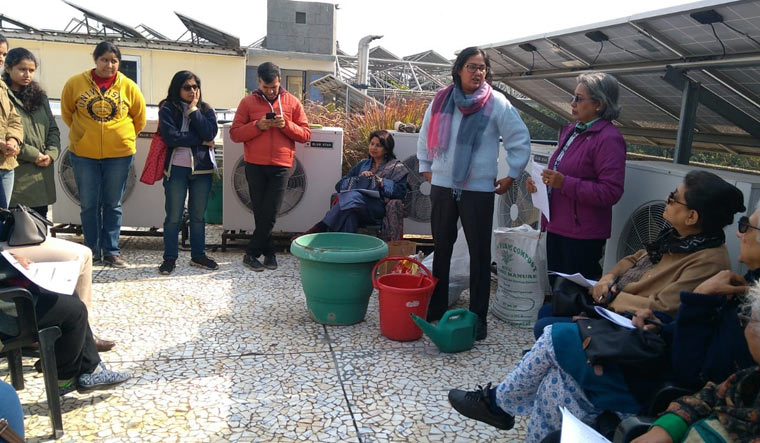Pesticides in vegetables has clearly scared residents of the highly polluted national capital enough to make them want to grow whatever vegetables they can on their terraces, balconies, tiny stand-outs of high rises and even kitchens and other windowsills. The trend is here to stay if one is to go by the attendance at the workshop on Urban Terrace Gardening.
An assorted group, largely woman, gathered on the terrace of the Indian National Trust for Art, Culture and Heritage (INTACH) building to attend the workshop by Ritu Singh, director of natural heritage division at INTACH. The event was part of a four-day utsav to celebrate the conservation of everything, from spaces to environment, arts,crafts and textiles to food grains, music and dance.
Singh spoke of the ecological gains of setting up a terrace garden and how it is also a stress buster. The participants wanted to grow everything, from microgreens to greens to lemon and mangoes and all the vegetables in between. Yes, it is possible, and easy too, she said .
She took them through different ways of composting kitchen waste, which was the best nutrient for plants, way better than the compost sold in the market. Next came the how-to-dos on mulching, which Singh said reduced the need to water the plants substantially, and protected the plants from the extreme temperatures. With the materials on hand, she demonstrated what it took to do all this, hands on.
The scarcity of soil in the city was a problem for many. The environmental conservationist suggested a mix of cocopeat and nursery-bought vermicompost which already had some soil, as a substitute. Arguably the best tip that she offered to the participants was to to choose regionally available vegetables instead of opting for exotic ones.
Much of the literature and websites on home gardening and kitchen gardening, whether on terraces or in the garden, come out of Bengaluru and Mumbai. These aren't perhaps the best guides for farmers and kitchen garden enthusiasts in the National Capital Region which faces extremes of summer and winter. Singh gave them a rule of thumb—don't do anything in extreme climates, save harvesting. The preferable time to sow vegetables in pots is mid-February to March and pre-monsoons.
“Start slow, grow what you need, don't get excited and tempted to try growing everything at once” she told them, as the participants walked around INTACH's terrace garden which is filled with spinach and tomatoes, sapodilla trees, banana plants and even tamarind trees.
At yet another session during the utsav, India's best known saree historian Rta Kapur Chishti who has authored many books on the subject, spoke of the different ways the unstitched garment is worn in different parts of the country. She came wearing a saree in a way that looked ever so original, inspired by the style of a rural drape by a poor community in Maharashtra. “Part of what I am wearing is a bit of Mangalagiri fabric, and it is attached to a saree” she revealed.
According to her, what made the saree different from an equal length and breadth of fabric from a bale was its composition—a body, two borders and two pallus. But just that is not enough to make it a saree the way weavers saw it. The borders, together, have to be at least twice the density and weight of the body, and the small pallu has to be four to five times the weight of the body, while the big pallu twice the weight of the small one, to make it “multipurpose” in terms of utility.
The way a saree is folded is enough to give away its length and breadth to the one who knows the garment. But the challenging part, Rta said, was that it was folded differently in every part of the country!
Rta knows 108 ways of wearing a saree, but says there are many more waiting to be discovered. At her demonstration of five different styles at the workshop, there was something conspicuously absent: the all important petticoat. The saree historian said it was never a part of the Indian garment, but the invention of Jnanadanandini Tagore. When the Tagore lady accompanied her husband to Mumbai, she was embarrassed by the Bengali style in which she wore it—without a blouse or a petticoat. And so came the petticoat, which only the Parsi women had adopted by then.
Her lecture was packed with details of how the British took over the manufacture of the saree and how the 80 varieties of cotton had now been reduced to 20. On a very ironical note, she said these 20 traditional varieties survived only outside temples across the country as they were used to make the wick with which the lamps are lit, and also the thread used in the Hindu 'janewoo' ceremony for boys.



